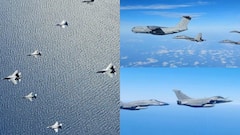ISRO Successfully Conducts Autonomous Landing Of Its Reusable Launch Vehicle Prototype: Know Everything
The mission, called RLV LEX, marks the first time a winged body has been carried to an altitude of 4.5 kilometres by a helicopter and released for carrying out an autonomous landing on a runway.

The Indian Space Research Organisation (ISRO) on Sunday, April 2, successfully conducted the autonomous landing test or air-drop landing experiment of the space agency's reusable launch vehicle prototype. The mission, called RLV LEX, was performed in collaboration with the Defence Space Research Organisation (DRDO), and the Indian Air Force (IAF), in the early hours of Sunday at the Aeronautical Test Range (ATR), Chitradurga, Karnataka.
The mission marks the first time a winged body has been carried to an altitude of 4.5 kilometres by a helicopter and released for carrying out an autonomous landing on a runway.
India 🇮🇳 achieved it!
— ISRO (@isro) April 2, 2023
ISRO, joined by @DRDO_India @IAF_MCC, successfully conducted the Reusable Launch Vehicle Autonomous Landing Mission (RLV LEX)
at the Aeronautical Test Range (ATR), Chitradurga, Karnataka in the early hours on April 2, 2023.
ISRO conducted the first experimental mission of its Reusable Launch Vehicle - Technology Demonstrator (RLV-TD) on May 23, 2016, from Satish Dhawan Space Centre, Sriharikota. As part of this experimental mission, critical technologies such as autonomous navigation, guidance and control, and the reusable thermal protection system were successfully demonstrated.
All about ISRO’s RLV LEX mission
One of the critical technologies that ISRO had to demonstrate was the approach and autonomous landing of the reusable launch vehicle prototype on a runway. The Indian space agency accomplished this milestone as part of the RLV-LEX mission. This was the second phase of the technology demonstration missions for the reusable launch vehicle prototype.
For the mission, the RLV-TD was carried at 7:10 am IST by a Chinook Helicopter of the Indian Air Force, as an underslung load. The RLV-TD flew to a height of 4.5 kilometres above mean sea level, ISRO said in a mission update.
Once the predetermined parameters were attained, the RLV-TD was released mid-air. The release conditions included 10 parameters, such as position, velocity, altitude and body rates, among others.
RLV-TD was released autonomously. After being released, it performed approach and landing manoeuvres using its Integrated Navigation, Guidance and Control System.
RLV-TD completed an autonomous landing on the ATR air strip at 7:40 am IST. With this, ISRO has successfully achieved the autonomous landing of a space vehicle.
The autonomous landing of RLV-TD was carried out under the exact conditions required for the landing of a space vehicle that has re-entered the atmosphere.
Conditions were simulated in a way such that the vehicle's speed was the same as what it would have had while arriving from space.
Landing parameters such as ground relative velocity, the sinking rate of landing gears, and precise body rates, which are likely to be experienced by an orbital re-entry space vehicle in its return path, were also taken into consideration.
The vehicle exhibited a high-speed autonomous landing at 350 kilometres per hour.
All about RLV-TD
The RLV-TD is one of the most technologically challenging endeavours of ISRO towards developing essential technologies for a fully reusable launch vehicle to enable low-cost access to space, the space agency says on its website.
RLV-TD has a configuration similar to that of an aircraft and combines the complexity of both launch vehicles and aircraft. RLV-TD is winged, a configuration intended to make the vehicle serve as a flying test bed to evaluate various technologies such as hypersonic flight, autonomous landing and powered cruise flight.
In the future, RLV-TD will be scaled up to become the first stage of India's reusable two-stage orbital launch vehicle.
RLV-TD has a length of 6.5 metres and a width of 3.6 metres. It consists of a fuselage or body, a nose cap, double-delta wings, and twin vertical tails, and features symmetrically placed active control surfaces called Elevons and Rudder.
RLV-TD is equipped with a conventional solid booster (HS9) that is designed for a low-burn rate.
The technology demonstrator has been developed using special alloys, composites and insulation materials, and crafted by highly skilled manpower.
The objectives of RLV-TD are the evaluation of autonomous navigation, guidance and control schemes, integrated flight management, and thermal protection system evaluation.
What's next?
Now that the RLV-LEX mission is complete, ISRO aims to accomplish the RLV Orbital Re-Entry Experiment (RLV ORE) milestone, according to the Vikram Sarabhai Space Centre (VSSC). As part of this mission, an ascent vehicle derived from the existing Geosynchronous Satellite Launch Vehicle (GSLV) and Polar Satellite Launch Vehicle (PSLV) stages will take a winged-body called orbital re-entry vehicle to orbit. The orbital re-entry vehicle will stay in orbit for a fixed time, and then re-enter Earth's atmosphere.
After this, the vehicle will autonomously land on a runway with a landing gear.
Related Video
India@2047 Summit: Modi Calls for Innovation, Reforms, and National Resolve






































